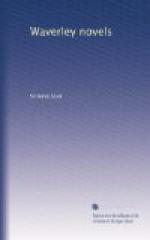NOTE 18
This happened on many occasions. Indeed, it was not till after the total destruction of the clan influence, after 1745, that purchasers could be found who offered a fair price for the estates forfeited in 1715, which were then brought to sale by the creditors of the York Buildings Company, who had purchased the whole, or greater part, from government at a very small price. Even so late as the period first mentioned, the prejudices of the public in favour of the heirs of the forfeited families threw various impediments in the way of intending purchasers of such property.
NOTE 19
This sort of political game ascribed to Mac-Ivor was in reality played by several Highland chiefs, the celebrated Lord Lovat in particular, who used that kind of finesse to the uttermost. The Laird of Mac—–was also captain of an independent company, but valued the sweets of present pay too well to incur the risk of losing them in the Jacobite cause. His martial consort raised his clan and headed it in 1745. But the chief himself would have nothing to do with king-making, declaring himself for that monarch, and no other, who gave the Laird of Mac —— ’half-a-guinea the day and half-a-guinea the morn.’
NOTE 20
In explanation of the military exercise observed at the Castle of Glennaquoich, the author begs to remark that the Highlanders were not only well practised in the use of the broadsword, firelock, and most of the manly sports and trials of strength common throughout Scotland, but also used a peculiar sort of drill, suited to their own dress and mode of warfare. There were, for instance, different modes of disposing the plaid, one when on a peaceful journey, another when danger was apprehended; one way of enveloping themselves in it when expecting undisturbed repose, and another which enabled them to start up with sword and pistol in hand on the slightest alarm.
Previous to 1720 or thereabouts, the belted plaid was universally worn, in which the portion which surrounded the middle of the wearer and that which was flung around his shoulders were all of the same piece of tartan. In a desperate onset all was thrown away, and the clan charged bare beneath the doublet, save for an artificial arrangement of the shirt, which, like that of the Irish, was always ample, and for the sporran-mollach, or goat’s-skin purse.
The manner of handling the pistol and dirk was also part of the Highland manual exercise, which the author has seen gone through by men who had learned it in their youth.
NOTE 21
Pork or swine’s flesh, in any shape, was, till of late years, much abominated by the Scotch, nor is it yet a favourite food amongst them. King Jamie carried this prejudice to England, and is known to have abhorred pork almost as much as he did tobacco. Ben Jonson has recorded this peculiarity, where the gipsy in a masque, examining the king’s hand, says—




